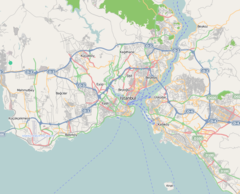Kara Ahmed Pasha Mosque
| Kara Ahmed Pasha Mosque | |
|---|---|
| Religion | |
| Affiliation | Islam |
| Location | |
| Location | Istanbul, Turkey |
| Geographic coordinates | 41°01′16″N 28°55′45″E / 41.02111°N 28.92917°E |
| Architecture | |
| Architect(s) | Mimar Sinan |
| Type | mosque |
| Groundbreaking | 1555 |
| Completed | c. 1572 |
| Materials | ashlar masonry |

The Kara Ahmed Pasha Mosque or Gazi Ahmed Pasha Mosque (Template:Lang-tr) is an Ottoman mosque near the city walls in Istanbul, Turkey.
The Kara Ahmed Pasha Mosque was designed by Mimar Sinan and completed in around 1572. Kara Ahmed Pasha was a grand vizier of Suleiman the Magnificent who was executed by strangulation in 1555. The mosque was planned in around 1555 but only constructed between 1565 and 1571-1572 when the pasha had been full exonerated.[1]
Architecture
The courtyard is surrounded by the cells of a medrese and a dershane, or main classroom. Attractive apple green and yellow tiles grace the porch, while blue and white ones are found on the east wall of the prayer hall. These tiles date from the mid 16th century. On the three galleries, the wooden ceiling under the west one is elaborately painted in red, blue, gold and black.[1] The mosque is last imperial building in Istanbul to be decorated with expressly designed cuerda seca tilework. Later buildings were decorated with tiles that were painted under a clear glaze.[2]
Notes
- ^ a b Necipoğlu 2005, pp. 377–384.
- ^ Atasoy & Raby 1989, p. 220.
Sources
- Atasoy, Nurhan; Raby, Julian (1989). Iznik: The Pottery of Ottoman Turkey. London: Alexandra Press. ISBN 978-1-85669-054-6.
{{cite book}}: Invalid|ref=harv(help) - Necipoğlu, Gülru (2005). The Age of Sinan: Architectural Culture in the Ottoman Empire. London: Reaktion Books. ISBN 978-1-86189-253-9.
{{cite book}}: Invalid|ref=harv(help)

